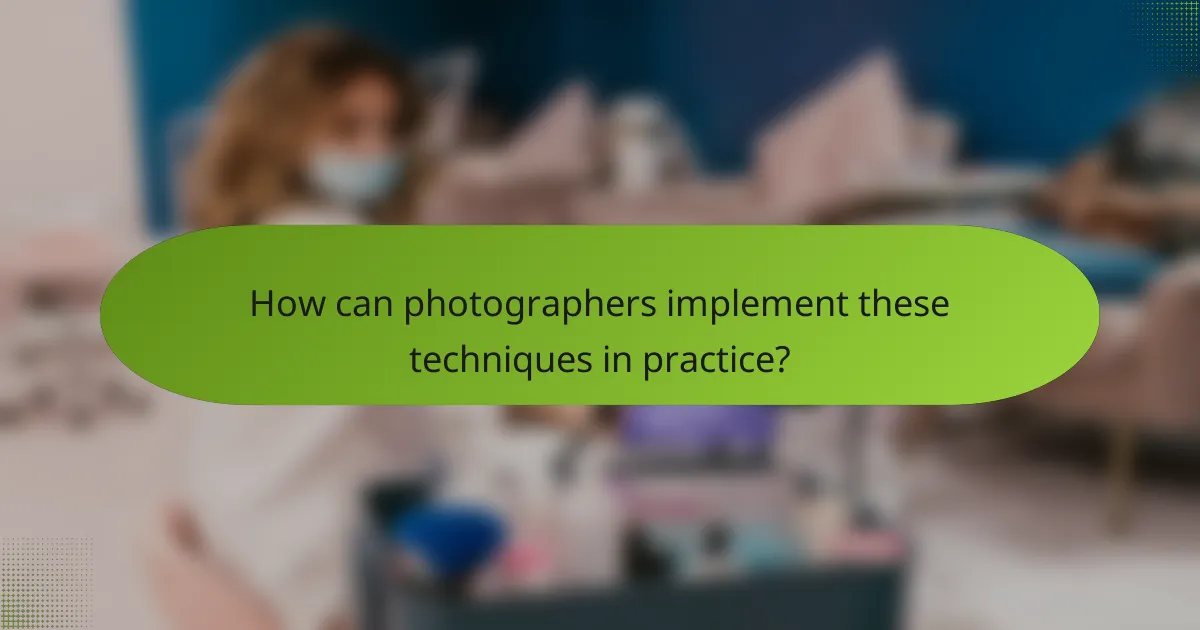
What are Techniques for Balancing Ambient and Artificial Light in Photography?
Techniques for balancing ambient and artificial light in photography include adjusting exposure settings, using reflectors, and employing gels. Adjusting exposure settings helps to control the brightness of the ambient light relative to the artificial light. Using reflectors can redirect ambient light to fill shadows created by artificial sources. Employing gels on artificial lights can match their color temperature to that of the ambient light. These techniques ensure a cohesive look in photographs, enhancing visual harmony. For instance, using a daylight-balanced gel can reduce color discrepancies between light sources.
How do ambient and artificial light differ in photography?
Ambient light is natural light that exists in a scene without any artificial sources. It can come from the sun, moon, or reflections from surfaces. Ambient light is often soft and diffused, creating a natural look in photographs. In contrast, artificial light is man-made and can include flash, lamps, or studio lights. Artificial light can be controlled in intensity and direction, allowing for creative effects. The key difference lies in their sources and characteristics. Ambient light is unpredictable and varies with time and weather. Artificial light provides consistency and can be tailored to achieve specific artistic goals.
What are the characteristics of ambient light?
Ambient light is the natural light that exists in a scene without direct artificial lighting. It provides a base level of illumination in photography. Ambient light is often soft and diffused, reducing harsh shadows. It varies in intensity and color temperature depending on the time of day and weather conditions. For example, sunlight during golden hour offers warm tones, while overcast days produce cooler hues. This type of light is essential for creating mood and atmosphere in images. Photographers often leverage ambient light to enhance the natural look of their subjects. Understanding its characteristics helps in achieving balanced exposures.
What are the characteristics of artificial light?
Artificial light is man-made illumination used in various settings. It can be produced by sources like incandescent bulbs, LEDs, and fluorescent lamps. Artificial light typically has a specific color temperature, measured in Kelvin, which affects its warmth or coolness. Most artificial lights emit a spectrum that can vary in intensity and color rendering index (CRI). The CRI indicates how accurately colors appear under the light compared to natural sunlight. Additionally, artificial light can be controlled in terms of intensity and direction, allowing for precise adjustments in photography. It often creates shadows and highlights that can enhance or detract from a subject. In photography, understanding the characteristics of artificial light is crucial for achieving balanced exposures and desired visual effects.
Why is balancing light important in photography?
Balancing light is crucial in photography because it ensures that the subject is well-lit and colors are accurately represented. Proper light balance prevents harsh shadows and overexposed highlights. This leads to more natural and visually appealing images. Photographers can achieve this by adjusting settings like ISO, aperture, and shutter speed. Additionally, using reflectors or diffusers can help manage light sources. Studies show that balanced lighting enhances the overall quality of photographs. For example, images with balanced light are more likely to engage viewers and convey the intended mood.
How does light balance affect image quality?
Light balance directly affects image quality by influencing exposure, color accuracy, and contrast. Proper light balance ensures that both ambient and artificial light sources work harmoniously. When light balance is off, images can appear overexposed or underexposed. This results in loss of detail in highlights or shadows. Additionally, incorrect light balance can lead to color casts, distorting the true colors of the scene. For example, tungsten lights can give a yellow tint if not balanced with daylight. Achieving the right light balance enhances clarity and depth, making images more visually appealing. Studies show that balanced lighting improves viewer engagement and perception of quality in photographs.
What common issues arise from poor light balance?
Poor light balance leads to several common issues in photography. One issue is color distortion. This occurs when artificial and ambient light sources have different color temperatures. Another issue is loss of detail. Poor light balance can create overly bright highlights or deep shadows, obscuring important elements in a photo. Additionally, poor light balance can result in a flat image. This happens when light sources do not create sufficient contrast, making the photograph appear dull. Lastly, it can cause eye strain for viewers. Images with poor light balance may be difficult to look at due to harsh lighting or color clashes.

What are the key techniques for achieving light balance?
Key techniques for achieving light balance include using reflectors, adjusting exposure settings, and employing diffusers. Reflectors help bounce light into shadowed areas, enhancing overall illumination. Adjusting exposure settings can compensate for discrepancies between ambient and artificial light sources. Employing diffusers softens harsh light, creating a more even distribution. Additionally, utilizing color temperature adjustments can harmonize different light sources. These techniques enhance the visual quality of photographs by ensuring a balanced light distribution.
How can photographers measure light effectively?
Photographers can measure light effectively using a light meter. A light meter quantifies the intensity of light in a scene. Photographers can use handheld light meters or built-in camera meters. Handheld meters provide precise readings for different lighting conditions. Camera meters measure light through the lens, offering convenience. Photographers should consider the scene’s dynamic range when measuring light. They can adjust exposure settings based on meter readings. Proper light measurement ensures accurate exposure and enhances image quality. Studies show that accurate light measurement leads to better photographic results.
What tools are available for measuring light in photography?
Light meters are essential tools for measuring light in photography. They help photographers determine the correct exposure settings. There are two main types of light meters: incident light meters and reflected light meters. Incident light meters measure the light falling on a subject. Reflected light meters measure the light reflecting off the subject. Many modern cameras have built-in reflected light meters. Photographers also use smartphone apps as portable light meters. These tools provide accurate readings to achieve optimal exposure.
How can the histogram assist in balancing light?
A histogram assists in balancing light by visually representing exposure levels in an image. It displays the distribution of tones from shadows to highlights. Photographers can identify if an image is overexposed or underexposed. A balanced histogram typically shows a spread across the entire range. This indicates proper exposure without clipping highlights or shadows. By analyzing the histogram, adjustments can be made to lighting or camera settings. This ensures that both ambient and artificial light are effectively balanced. Proper balance enhances image quality and detail retention.
What methods can be used to balance ambient and artificial light?
To balance ambient and artificial light, photographers can use several methods. Adjusting the white balance settings on the camera is essential. This ensures that the colors in the image are accurate under mixed lighting conditions. Using diffusers can help soften artificial light, making it blend more naturally with ambient light.
Another method is to control the intensity of artificial light sources. Dimming lights or using lower wattage bulbs can reduce the impact of artificial light. Additionally, using reflectors can help direct ambient light onto the subject, creating a more balanced exposure.
Finally, shooting during the golden hour can provide a natural balance between ambient light and artificial sources. This time offers soft, warm light that complements artificial lighting well. These methods can significantly enhance the quality of photographs by creating a harmonious light balance.
How does white balance play a role in light balancing?
White balance is crucial in light balancing as it adjusts the colors in an image to appear more natural. It compensates for different light sources, which can cast various color tints. For instance, incandescent bulbs emit a warm yellow tone, while fluorescent lights can give a cooler bluish tint. By setting the correct white balance, photographers ensure that whites appear true to life. This adjustment helps maintain color accuracy across the entire image. Inaccurate white balance can lead to unnatural color casts, affecting the overall quality of the photograph. Many cameras offer automatic white balance settings to simplify this process. However, manual adjustments can yield better results in challenging lighting conditions.
What are the advantages of using diffusers and reflectors?
Diffusers and reflectors enhance lighting in photography by modifying light quality and direction. Diffusers soften harsh light, reducing shadows and creating a more even illumination. They help in achieving a natural look, especially in portrait photography. Reflectors bounce light back onto the subject, filling in shadows and adding brightness. This technique allows for better control over the light balance. Both tools improve image quality by enhancing colors and reducing glare. They are essential for achieving professional results in various lighting conditions.

How can photographers implement these techniques in practice?
Photographers can implement techniques for balancing ambient and artificial light by using specific tools and methods. They should start by assessing the ambient light conditions in their shooting environment. This involves measuring the existing light with a light meter or by using the camera’s histogram.
Next, photographers can adjust their camera settings, such as ISO, shutter speed, and aperture, to suit the ambient light level. They can also introduce artificial light sources, like flash or continuous lights, to complement the ambient light.
Using modifiers like softboxes or reflectors can help diffuse and control the artificial light, creating a more natural blend. Additionally, photographers can experiment with the color temperature of both ambient and artificial lights to ensure they match.
For instance, using gels on artificial lights can help achieve color harmony. Finally, practicing these techniques in various lighting conditions will enhance a photographer’s skill in balancing light effectively.
What are some practical tips for balancing light in various environments?
To balance light in various environments, adjust your camera settings to compensate for different light sources. Use a lower ISO in bright environments to reduce noise. In darker settings, increase the ISO to enhance sensitivity. Adjust the aperture to control the amount of light entering the lens. A wider aperture allows more light, while a smaller aperture reduces it. Utilize white balance settings to correct color tones. Different light sources have varying color temperatures, impacting the image’s overall hue. Use reflectors or diffusers to manipulate natural light effectively. This can soften harsh shadows and create a more balanced exposure. Experiment with the positioning of lights to find the optimal balance. Positioning can significantly affect how light interacts with the subject. Understanding these techniques can lead to improved photography results.
How can outdoor settings influence light balance techniques?
Outdoor settings significantly influence light balance techniques in photography. Natural light varies in intensity and quality due to factors like time of day, weather, and surrounding elements. For instance, golden hour provides soft, diffused light that enhances subjects, while harsh midday sunlight can create strong shadows. Photographers must adjust their settings to compensate for these variations.
Using reflectors can help redirect natural light to fill shadows, improving balance. Additionally, the presence of elements like trees or buildings can create dappled light, requiring careful exposure adjustments. Understanding these outdoor influences allows photographers to achieve optimal light balance, enhancing the overall image quality.
What adjustments should be made for indoor photography?
Adjustments for indoor photography include optimizing lighting conditions and camera settings. Use a tripod to stabilize your camera for longer exposure times. Increase the ISO setting to enhance sensitivity to light, which compensates for low-light conditions. Adjust the white balance to match the light source, ensuring accurate color representation. Utilize additional lighting sources, such as softboxes or reflectors, to fill in shadows. Experiment with aperture settings to control depth of field and light intake. Consider the use of natural light by positioning subjects near windows. These adjustments collectively improve image quality in indoor settings.
What common mistakes should photographers avoid when balancing light?
Photographers should avoid overexposing or underexposing their images when balancing light. This mistake often results in loss of detail in highlights or shadows. Another common error is ignoring the color temperature of light sources. Mismatched temperatures can lead to unnatural skin tones. Photographers frequently forget to use reflectors or diffusers. These tools help to soften harsh light and create a more balanced effect. Additionally, relying solely on automatic settings can hinder creative control. Manual adjustments allow for precise light balancing. Lastly, neglecting the background light can create unwanted distractions. Paying attention to all light sources ensures a cohesive image.
How can overexposure or underexposure impact the final image?
Overexposure results in a final image that is too bright, losing detail in highlights. This occurs when the sensor receives too much light. Details in bright areas may become completely white, a phenomenon known as ‘blown highlights.’ Underexposure leads to a final image that is too dark, obscuring details in shadows. This happens when the sensor receives insufficient light. Dark areas may appear as solid black, losing texture and depth. Both conditions can detract from the overall quality of the image. Proper exposure is essential for capturing a balanced and detailed photograph.
What are the pitfalls of relying solely on artificial light?
Relying solely on artificial light can lead to several pitfalls in photography. Artificial light often lacks the natural warmth and color accuracy found in sunlight. This can result in images that appear unnatural or unappealing. Additionally, artificial lighting can create harsh shadows and highlights, which may detract from the subject’s details.
Overexposure is another risk, as artificial lights can be more intense and difficult to control. This can lead to loss of detail in bright areas. Furthermore, solely using artificial light can limit the photographer’s creativity and adaptability. Natural light changes throughout the day, offering varied textures and moods that artificial light cannot replicate.
Lastly, prolonged reliance on artificial light can lead to a less authentic representation of the scene. Photography aims to capture reality, and using only artificial sources can distort that reality.
What are the best practices for consistent light balance in photography?
Use a gray card to set the correct white balance before shooting. This ensures accurate color representation in your images. Adjust your camera settings to match the lighting conditions. For mixed lighting, use a color temperature meter for precision. Maintain consistent light sources when possible. This reduces color shifts during post-processing. Use reflectors to fill shadows and balance light intensity. Softboxes can diffuse light for a more even distribution. Regularly check your histogram to monitor exposure levels. Proper exposure supports consistent light balance across images.
How can photographers develop a routine for assessing light conditions?
Photographers can develop a routine for assessing light conditions by consistently evaluating their shooting environment. They should begin by observing the natural light at different times of day. This includes noting the direction, intensity, and color temperature of the light. Photographers can use a light meter to measure the light’s intensity accurately. They should also practice adjusting their camera settings based on these measurements.
In addition, utilizing tools like gray cards can help in determining correct exposure. Photographers can document their observations in a notebook or digital format. This practice enhances their understanding of light patterns over time. Research indicates that consistent light assessment leads to improved photographic outcomes.
What role does post-processing play in achieving light balance?
Post-processing plays a crucial role in achieving light balance in photography. It allows photographers to adjust exposure, contrast, and color temperature after the image is captured. These adjustments can correct any imbalances between ambient and artificial light sources. For instance, software like Adobe Lightroom or Photoshop enables users to modify highlights and shadows. This helps to unify the overall lighting in the image. Additionally, color grading tools can be used to ensure that the tones from different light sources match more closely. Studies show that effective post-processing can enhance the visual harmony of an image, making it more appealing.
Techniques for balancing ambient and artificial light in photography are essential for achieving visually appealing images. This article covers various methods including adjusting exposure settings, using reflectors, and employing gels to harmonize different light sources. It discusses the characteristics of ambient and artificial light, the importance of light balance for image quality, and common issues arising from poor light balance. Additionally, it provides practical tips for measuring light, utilizing tools like light meters and histograms, and implementing effective strategies for both indoor and outdoor photography settings.
